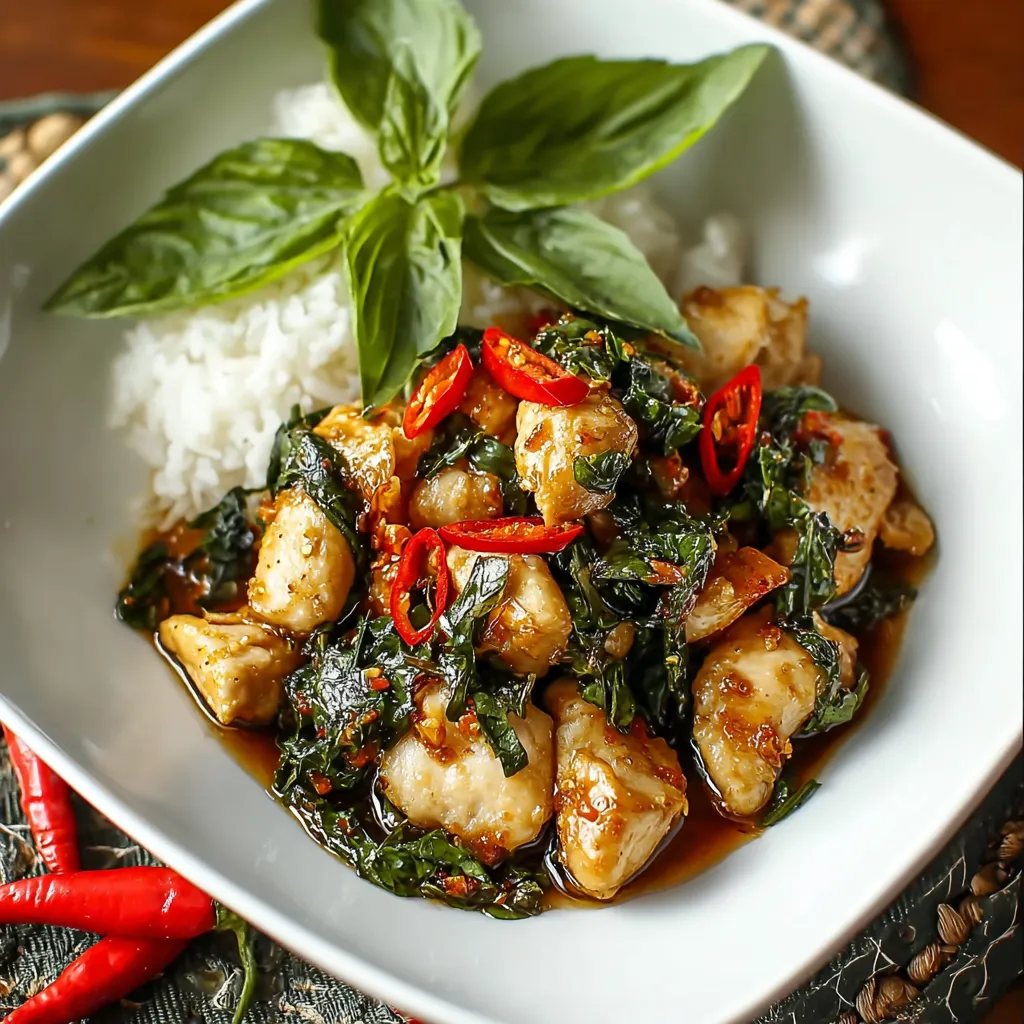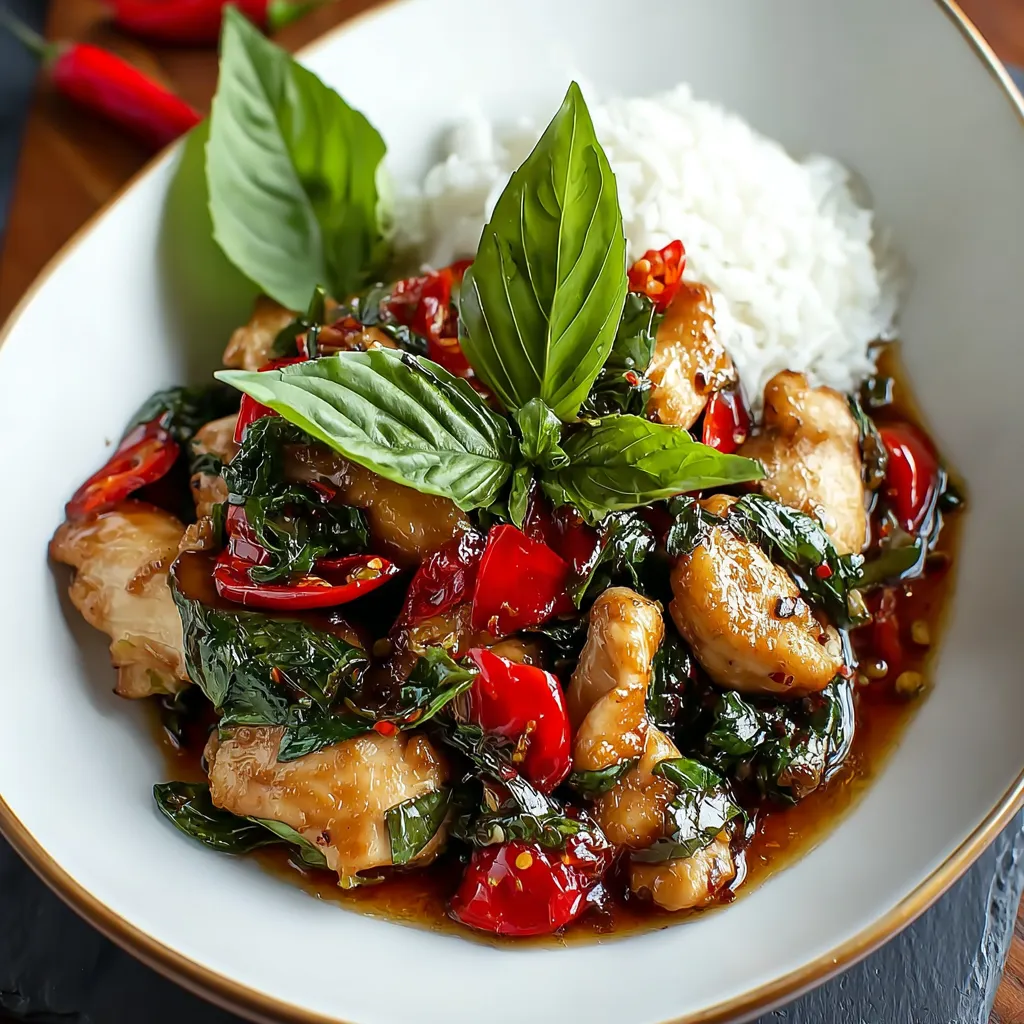 Bookmark
Bookmark
This Thai Basil Chicken has become my absolute lifesaver on busy weeknights when I crave something vibrant and satisfying without spending hours in the kitchen. The aromatic basil and savory sauce create a restaurant-quality meal that comes together in minutes.
I first made this dish after returning from a trip to Thailand, desperate to recreate those incredible street food flavors. My first attempt was actually too spicy for my family to eat, but after some adjustments, it's now requested at least once a week in our home.
Ingredients
- Boneless skinless chicken thighs provide much more flavor than breast meat and stay tender even with quick cooking
- Vegetable oil with its neutral flavor lets the aromatics shine
- Garlic and shallots create the aromatic foundation of authentic Thai flavor
- Red chili brings customizable heat use Thai bird chilies for authenticity or jalapeños for milder spice
- Bell pepper adds sweetness and crunch to balance the savory elements
- Fresh basil leaves preferably Thai basil but regular basil works in a pinch
- Oyster sauce delivers rich umami and subtle sweetness that makes the sauce irresistible
- Soy sauce brings salt and depth to the sauce
- Fish sauce might smell strong but adds that unmistakable Thai flavor profile
- Sugar balances the saltiness and heat
- Chicken broth creates a silky sauce that coats every bite
Step-by-Step Instructions
- Heat the Oil
- Pour the vegetable oil into a large wok or heavy skillet and heat over medium high heat until shimmering but not smoking. Having your pan properly heated before adding ingredients ensures proper searing rather than steaming.
- Create the Aromatic Base
- Add the minced garlic and sliced shallots to the hot oil, stirring constantly to prevent burning. Cook for about 60 seconds until they release their fragrance but before they turn brown. This aromatic foundation flavors the entire dish.
- Cook the Chicken
- Add your sliced chicken thighs to the pan, spreading them out to maximize contact with the hot surface. Let them cook undisturbed for about 2 minutes before stirring to develop some caramelization. Continue cooking for another 3 5 minutes until the chicken is no longer pink. Chicken thighs are forgiving even if slightly overcooked.
- Add the Vegetables
- Toss in the sliced red chili and bell pepper, stirring to combine with the chicken. Cook for 2 3 minutes until the peppers begin to soften but still maintain some crispness. The vegetables should be tender crisp not mushy.
- Create the Sauce
- In a small bowl whisk together the oyster sauce, soy sauce, fish sauce, sugar and chicken broth until well combined. Pour this mixture over the chicken and vegetables, using a wooden spoon to scrape up any flavorful bits from the bottom of the pan. Let it bubble gently for 2 3 minutes until slightly thickened.
- Finish with Basil
- Turn off the heat and immediately add the fresh basil leaves. Gently fold them into the hot mixture just until they begin to wilt. The residual heat will cook them perfectly while preserving their aromatic oils and vibrant color.
- Season and Serve
- Taste the dish and adjust with salt and pepper if needed. Remember that soy sauce and fish sauce are already salty so additional salt may not be necessary. Serve immediately over steamed jasmine rice for an authentic experience.

My absolute favorite part of this dish is how the basil perfumes everything with its distinctive aniseed aroma. My daughter who normally picks herbs out of everything actually requests extra basil in this dish. I think it reminds her of our trip to Bangkok where we ate similar street food from a tiny stall near our hotel.
The Secret to Authentic Flavor
The real magic of Thai Basil Chicken lies in the balance of flavors. Traditional Thai cooking aims to incorporate all five taste elements sweet from sugar salty from soy sauce sour from a squeeze of lime if desired bitter from the basil and spicy from the chilies. When making this at home dont be afraid to taste and adjust as you go. Thai cuisine is highly personal and regional with each cook adding their own signature balance.
Make It Your Own
This recipe is incredibly adaptable to what you have on hand. No bell peppers? Try sliced carrots green beans or even broccoli florets. Vegetarian? Substitute firm tofu or tempeh for the chicken just make sure to press the tofu well before cooking. For a lower carb option serve over cauliflower rice or wrapped in lettuce cups instead of traditional jasmine rice. The sauce works beautifully with nearly any protein or vegetable combination.
Storage and Reheating
Thai Basil Chicken actually improves overnight as the flavors meld together making it perfect for meal prep. Store leftovers in an airtight container in the refrigerator for up to 4 days. The basil will darken somewhat but the flavor remains excellent. To reheat add a splash of water or chicken broth to prevent drying out and warm gently in a skillet over medium heat. Avoid microwave reheating if possible as it tends to make the chicken tough and overcooked.
Serving Suggestions
While jasmine rice is the traditional accompaniment try serving this dish with coconut rice for an extra layer of flavor. Simply replace half the water with coconut milk when cooking your rice. A side of cucumber salad dressed with rice vinegar provides a cooling contrast to the spicy chicken. For a complete Thai feast consider starting with a simple tom kha soup or spring rolls before serving the main course.
Common Recipe Questions
- → What is the best type of basil to use for Thai Basil Chicken?
Thai holy basil (bai gaprow) is traditional and offers the most authentic flavor with its peppery, anise-like taste. However, Thai sweet basil or even regular Italian basil can work in a pinch. For the best results, use fresh basil rather than dried, as the aromatic oils are essential to the dish's character.
- → Can I make this dish vegetarian?
Absolutely! You can substitute the chicken with firm tofu, tempeh, or a variety of vegetables like mushrooms and eggplant. Replace the fish sauce with soy sauce or vegetarian mushroom sauce, and use vegetable broth instead of chicken broth. The key flavors will remain intact with these simple swaps.
- → How spicy is Thai Basil Chicken typically?
Traditional Thai Basil Chicken is quite spicy. However, you can easily adjust the heat level by controlling the amount and type of chilies you use. For a milder version, remove the seeds from the chilies or reduce the quantity. For extra heat, add Thai bird's eye chilies or a dash of chili paste.
- → What side dishes pair well with Thai Basil Chicken?
While jasmine rice is the classic accompaniment, you could also serve it with coconut rice for added richness. Other complementary sides include a fresh cucumber salad, spring rolls, tom yum soup, or simple stir-fried vegetables. For a lower-carb option, serve with cauliflower rice or lettuce wraps.
- → How do I store and reheat leftover Thai Basil Chicken?
Store leftovers in an airtight container in the refrigerator for up to 3 days. When reheating, add a splash of water or broth to prevent the dish from drying out. Microwave on medium power or gently reheat in a wok. The flavors often deepen overnight, making leftovers particularly delicious the next day.
- → Is there a way to make this dish ahead of time?
You can prepare components ahead of time: slice the chicken and vegetables, and mix the sauce ingredients in advance. Store these separately in the refrigerator. For best results, cook the dish just before serving, as the fresh basil loses its vibrant flavor and texture when reheated. If needed, fully cook without the basil, then reheat and add fresh basil just before serving.
